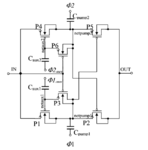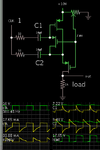sa126997
Newbie level 4
this is E. Racape and J.-M.Daga's charge pump


it use 4 Phases Non-Overlapping Clock to switch pmos P1,P5,P2,P4
if P1 and P5 are ON, P2 and P4 are OFF, else if P2 and P4 are ON, P1 and P5 are OFF.
and my question is
what are p3 and p6 work on which Active region,and p3 p6 on the function of the circuit?
- - - Updated - - -
sorry the question is p3 and p6 work on which region,and p3 p6 on the function of the circuit?


it use 4 Phases Non-Overlapping Clock to switch pmos P1,P5,P2,P4
if P1 and P5 are ON, P2 and P4 are OFF, else if P2 and P4 are ON, P1 and P5 are OFF.
and my question is
what are p3 and p6 work on which Active region,and p3 p6 on the function of the circuit?
- - - Updated - - -
sorry the question is p3 and p6 work on which region,and p3 p6 on the function of the circuit?
